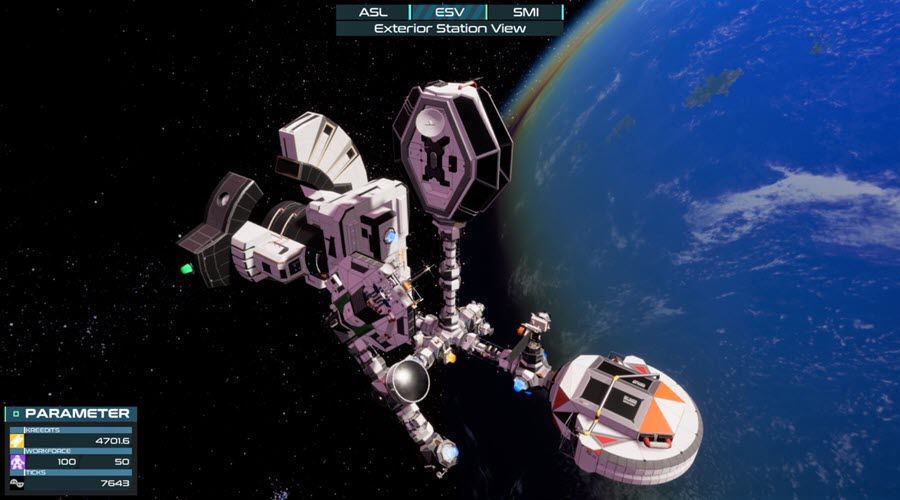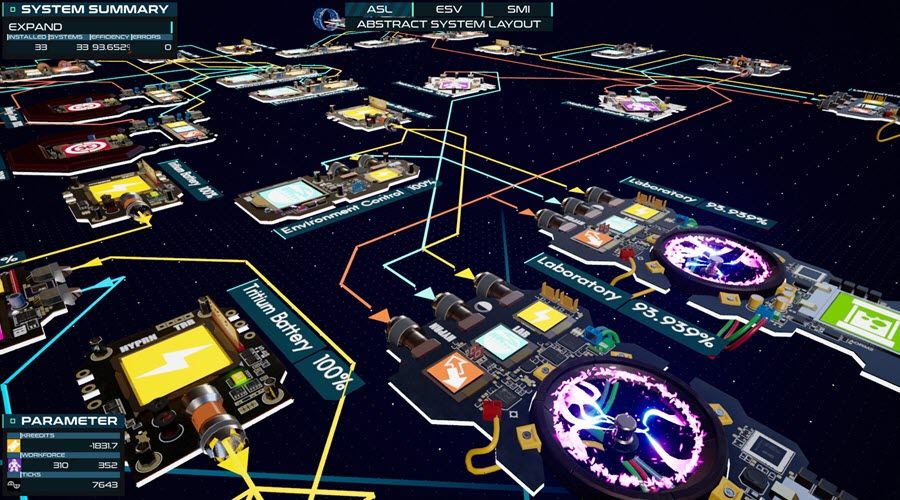orbit.industries

Review
Have you ever wanted to create your own space station? Well, here’s your chance. You’ll be able to select from six mission types: No Time For Caution, Second Home, Protective Shield, Trade Route, Endless and Creative. You can choose to customise your missions by choosing from three difficulty options in both Economy and Errors. Depending on the difficulty you choose in Economy, you will have less or more revenue for projects. In the Errors category, there will be fewer and less harmful errors in the lowest difficulty, increasing to additional and more severe errors for highest difficulty, all of which can help you to decide how easy or tough you want your game to be.
Playing Endless and Creative mission types allows you to build and create your space station as you wish without the constraints of time and money that would apply if you started from scratch. The final four mission types will have you accomplish various tasks in order to complete the mission. The tasks can be found in the Station Management Interface (SMI) under Procurement. Also in the SMI is the Station Overview and Finance Overview. In Procurement you’ll find Cluster Projects, System Activity and Project Database. Cluster Projects will display any available projects (tasks) currently available to you.
The available projects come under Contracts, Research, Mission and Open Positions (all projects currently available, including the other topics). Mission is where you’ll have to complete the tasks if you want to fulfill your mission objective. To do this you will have to follow one task which will unlock another and so on. The tasks will have some background and your AI will tell you all about what is happening; for example, you may need to research and break some data encryption to unlock the hidden information.
To find the information you’ll have to accept the mission, however you can only do this if you have the required resources. Mission projects usually require the resources produced by various modules on your space station. If these requirements aren’t fulfilled, then you won’t be able to select that mission. If this happens then you’ll have to build the corresponding module or modules, although as you progress you will need to research some technology before being able to add them to your space station.

Researching new tech for your station will have various requirements similar to the mission requirements, which is certain modules and time. It takes time and money to build a space station and to use it to its fullest, and this is where Contracts comes in to play. Selecting a Contract will have requirements just like Research and Mission, but upon completion you’ll be granted some much-needed pennies. You’re going to have to watch those pennies, as they go down fast once you start building and then have the upkeep of the station.
So, you’re going to want those Contracts to keep flowing, but at times this will have you wondering whether you should do this or that, as resources from your station modules are being used more and more. Building more modules will help, and you will require multiple modules of the same type for some of the projects. But, then you hit the same problem, money starts to dwindle, so you’re going to have to find that sweet spot of upgrading your station, researching and completing contracts to pay for it all. Once a contract or mission is completed you must access the project from the completed pile in Cluster Projects, which will then close the project and give you any reward for completion.
To build a module on your station you need to switch from the SMI to ESV (Exterior Station View). Here you can add modules such as Airlock, Laboratory, Environment Control and any others which you require in order to complete your mission. To expand your station, you have access to various connectors which can be used to expand your station outwards, placing the modules along these connectors.
Once your module is built, there’s still some work to do before you can start making use of your newest inclusion. To finalise your module you must wire it into the space station's systems. This is done by visiting the Abstract System Layout (ASL), where you can add your shiny new module into the station’s system. Once connected, you’ll be able to start using the module’s resources to complete contracts, research and missions. Each module will have its own requirements and not all modules will connect to each other.
As your station grows, you’ll put pressure on your systems; not enough power or too many modules sharing the same resources while doing missions or contracts will slow down your station or even bring it to a halt. There are hazards you will have to put up with, and errors in the system or fires can spread between modules causing untold damage, slowing or corrupting your station.
In the settings you’ll find options for Game (Display Language ESV and ASL Invert Vertical and Horizontal Camera Axis and Invert ASL Drag), Video (Monitor, Resolution, Screen Mode, Upscale Mode, Upscale Quality, V-Sync, FPS Limit, HDR, HDR UI Brightness, Overall Quality, Anti-Aliasing, Textures, Post Processing, Shadows, Effects, API, Raytracing Shadows and Reflections), Audio (Master, Music, Effects, UI, AI Volume Controls and AI Voice - Male or Female), Controller and Keyboard Binds and Controls.
In space they can’t hear you scream; they could hear me screaming when I first started playing the game. I had a couple of issues with the game. I thought the UI in the Station Management Interface could be a little bit smaller and neater. The yellow background icons are hard to see, so being able to hover over an icon to get some information on it would help greatly.
At times you must build something on a mission, but that something is nowhere to be found through the interface. Checking the research reveals nothing, so you’re left scratching your head wondering how on earth you’re going to continue when all you have is a greyed-out icon along with a three-letter abbreviation to go on. If you don’t figure it out or do the right thing, then it’s going to be game over.
I was unable to figure out what the hell I was supposed to do, running out of money or not having enough workforce, even though I had plenty of habitats built. The AI was screaming the same thing at me over and over and driving me up the wall! Eventually I kind of worked it out, although there are some things I still don’t understand; I’ll get there.
One time I had a mission which wouldn’t finish; even though I had everything at 100% I wasn’t able to close the mission. Instead, all I could do was wait until I had run out of money and collect my Game Over.
When on the ESV screen I liked to have the planet in view, but trying to get the right angle with the camera often proved to be very awkward (you move the camera angle by holding mouse button down and moving it around). If you were able to spin through the vertical and horizontal axis, things might be a little bit easier.
Review written by Piston Smashed™ for Zeepond.com
orbit.industries Steam Store Page
Positives
+ Nice looking graphics+ Multiple game modes
+ Has achievements
+ Steam cloud
Negatives
- Frustrating at times- ESV awkward camera movement
- Unable to find information on something
- No cards currently
Review Summary
Manage resources and your economy as you build your space station above the Earth or above some other far-off planets, in orbit.industries.
Share this review!
Zeepond Rating: 6/10










Video
Game Categories
All Game Reviews (1356)Hardware Reviews (0)
Action (341)
Adventure (151)
Alpha Games (2)
Anime (5)
Board Games (3)
Casual (135)
First Person (19)
First Person Shooter (30)
Hardware (0)
Horror (38)
Massive Multiplayer Online (4)
Pixel Graphics (23)
Platformer (94)
Puzzles (65)
Racing (26)
Role Playing Game (62)
Simulation (53)
Sports (20)
Strategy (246)
Third Person (12)
Utility software (1)
Virtual Reality (22)

